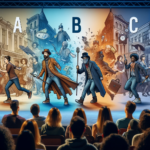As I delve into teaching large language models how to perform in improv theater, I’ve discovered an intriguing aspect: I’m learning a lot about improv itself. Many concepts that seem instinctive to us are quite challenging for a beginner like a language model. This pushes me to rethink and rearticulate these concepts so that a model can process them.
One key challenge is understanding the flow of time. Unlike humans, language models, based on historical data, may not inherently grasp this concept. In improv, time progression is vital, especially in long-form scenes, leading to potential contradictions.
Consider this: a scene starts at Location A, moves to Location B through a cut, and then to Location C. In improv, this is normal, and audiences can easily follow. However, for a language model, managing three locations can be confusing. While it might remember the last location, there’s no guarantee, especially if its context window overflows, causing earlier locations to be ‘forgotten’ – unlike in the minds of players or audience.
This led me to experiment with a new exercise. It involves a group of three players performing a scene with location changes. After about five minutes, the scene is paused, and three new players, who were outside and unaware of the scene’s details, are briefed only through the recollections and descriptions of the first group. These new players then continue the scene from where it was left off. This is fascinating for the audience, who only see the seamless transition and the story’s conclusion.
I anticipate this exercise will be entertaining and enlightening. It will likely reveal much about subconscious processes, communication misunderstandings, and the humorous scenes that emerge. I’m excited to try this with my improv groups soon and will report back on the findings.
